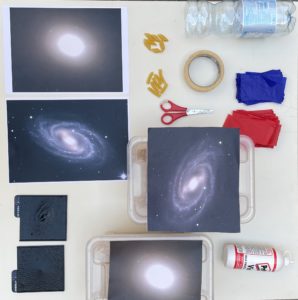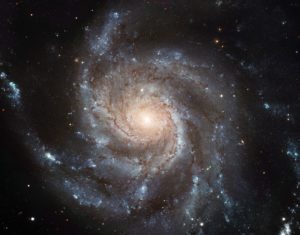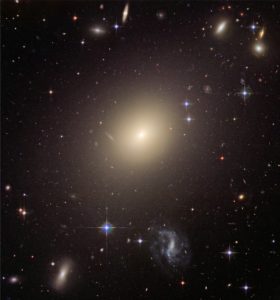Teaching activity planned by Stefano Giarratana, Emanuele De Rubeis, Cristina Nanci, Xavier Lopez Lopez and Davide Pellicciari during the Phd course “Designing innovative public engagement activities” held at the University of Bologna in 2023.
Short description of the activity:
The galaxies which make up our Universe are of various types, each one with a different shape and features. The goals of this activity is discovering the main differences between two particular categories of galaxies: spiral galaxies and elliptical galaxies. Just like astronomers, we will find out which of the two contains older stars, so as to obtain further clues on the evolution of our Universe over time. Moreover, each participant will build up his/her own model of the galaxy!
 Materials
Materials
- Two boxes
- Pasta (a packet of fusilli and one of pennette)
- 4 plastic bottles of 2 liters, cut about 10 cm from the cap
- Sheets of red and blue tissue paper
- Printouts of both an elliptical and a spiral galaxy (in quantities equal to the number of participants, download available here)
- Vinyl glue
- Scissors
- (optional) 3D Printouts of galaxies, both elliptical and spiral
Preparation of the activity
Before starting the activity, fill both boxes with two types of pasta, on different terms, so that one box contains more fusilli than pennette, and the other one more pennette than fusilli (for example, fill one box with a 70% of pennette and 30% of fusilli, whereas the other one with 80% of fusilli and 20% of pennette).
The boxes represent the galaxies, fusilli young stars contained and pennette older stars. La scatola con più fusilli (stelle giovani) rappresenta una galassia a spirale, mentre quella con più pennette (stelle vecchie) rappresenta una galassia ellittica.
After closing the boxes, place the 3D printout of the elliptic galaxy upon the box with more pennette, and the one of the spiral galaxy upon the box with more fusilli. Place 2 empty bottles next to each box.
Divide the participants into two groups and assign a box to each group.
The minimum age recommended is 8 years.
Description of the activity
Introduzione
The activity starts with an introduction to the concepts of galaxy and their age (see the section “Explanation of the physical process” for further details).
In order to encourage a collective discussion rather than a frontal explanation, you can ask various questions, such as “Do you know what a galaxy is? And a star? According to you, are stars all the same? And galaxies?”. Show the images of the spiral and elliptical galaxies, so as to talk about their different shapes.
Galaxies are systems formed by gas, dust and stars. The stars contained inside may be of various types, both for color, size, and age. The age of galaxies is based upon the percentage of old stars which it contains: the larger the quantity, the older the galaxy will be, and viceversa.
Carrying out the activity
1. Ask each group to open their own box/galaxy and separate fusilli (young stars) from pennette (old stars) placing them in the two bottles, after explaining the analogy (old stars are pennette, whereas the young ones are fusilli)
2. After dividing the pasta, ask the groups to evaluate which of the two galaxies/boxes contains more young stars (fusilli) and which quale contains more old stars (pennette)
3. Discuss with the groups the possible reasons why the spiral galaxy is younger than the elliptical galaxy.
The galaxy/box with the higher quantity of old stars is the elliptical galaxy, whereas the one with young stars is the spiral galaxy. The reason for this difference is the different content of gas of the two galaxies, the main ingredient for new stars. Young (spiral) galaxies contain a lot of gas and therefore continue to form new stars. On the other hand, old (elliptical) galaxies have already exhausted all their gas for two reasons: first of all because, though old, have had so much time to form as many stars as possible, and – secondly – during their long life they interacted with other galaxies, and this interaction made the gas they contained “leak away”.
Construction of one’s own galaxy
The last part of the activity consists in building one’s own galaxy.
1. Make each participant choose an image of a spiral or elliptical galaxy.
2. Prepare the stars by crumbling small balls of tissue paper, blue for young stars and red for old stars.
3. Tape the stars upon the image of the chosen galaxy, while trying to respect the general guidelines learnt during the activity (more young stars for the spiral galaxy, and more old stars for the elliptical galaxy.

Explanation of the physical process
What is a star, and what is a galaxy?
We can think of a star as a huge sphere of gas, mainly formed by hydrogen. A star for most part of its life it burns all the gas it has through nuclear reactions, transforming it into heavier elements. This process creates a huge quantity of energy, which is then released in the form of light.
In-depth study: life of a star: from birth to death
Stars, together with dust and gas, compose galaxies. In fact, inside each of them there are about 100 billion stars, all different one from the other for their chemical composition, mass, temperature, dimension, but mainly for their age. Each galaxy has a different number of young stars (with an age of a few hundred million years) and old stars (with an age which may even reach one billion years). A galaxy which has mainly old stars will therefore be older than a galaxy which contains more young stars.
In-depth study: Galaxies, formation and morphology
Young Galaxies, old Galaxies

Spiral galaxies (like the one in the image on the left) have a lot of gas and matter in their arms, which is fundamental to form new stars: the arms of spiral galaxies act therefore as “star maternity wards”, where gas and dust can condense and create new stars. It is a bit like a large factory of stars, which keeps producing new stars.

On the other hand, elliptical galaxies (like the one in the image on the right) have fewer young stars because they have used up almost all their stock of matter to form new stars. This can be due to various reasons: some elliptical galaxies are older and have had sufficient time to create as many stars as possible, whereas other elliptical galaxies might have lost their gas and dust because of the interaction with other galaxies in the course of time.
